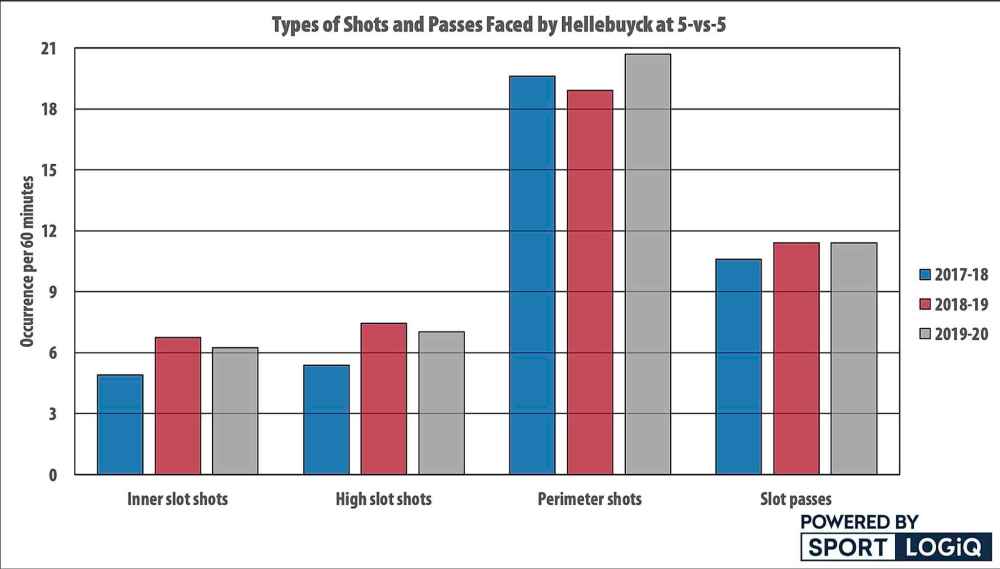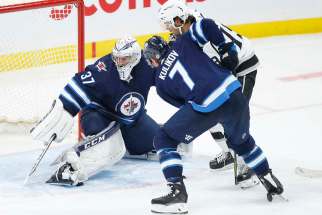Jets have many problems, but Hellebuyck isn’t one of them
Read this article for free:
or
Already have an account? Log in here »
To continue reading, please subscribe:
Monthly Digital Subscription
$0 for the first 4 weeks*
- Enjoy unlimited reading on winnipegfreepress.com
- Read the E-Edition, our digital replica newspaper
- Access News Break, our award-winning app
- Play interactive puzzles
*No charge for 4 weeks then price increases to the regular rate of $19.00 plus GST every four weeks. Offer available to new and qualified returning subscribers only. Cancel any time.
Monthly Digital Subscription
$4.75/week*
- Enjoy unlimited reading on winnipegfreepress.com
- Read the E-Edition, our digital replica newspaper
- Access News Break, our award-winning app
- Play interactive puzzles
*Billed as $19 plus GST every four weeks. Cancel any time.
To continue reading, please subscribe:
Add Free Press access to your Brandon Sun subscription for only an additional
$1 for the first 4 weeks*
*Your next subscription payment will increase by $1.00 and you will be charged $16.99 plus GST for four weeks. After four weeks, your payment will increase to $23.99 plus GST every four weeks.
Read unlimited articles for free today:
or
Already have an account? Log in here »
Hey there, time traveller!
This article was published 25/10/2019 (2236 days ago), so information in it may no longer be current.
There are a lot of things to be worried about with the Winnipeg Jets this season; the heavy losses to the defensive core, captain Blake Wheeler’s play not being up to his usual standard and a losing record with a negative goal differential near the end of October.
One area that should give fans confidence though, is the play of Connor Hellebuyck.
Over the course of the previous two seasons the Jets went from being one of the better defensive teams in the league to decidedly mediocre. In the first half of last year Hellebuyck bore the brunt of the blame, facing a lot of criticism as his play looked very poor, on the surface.

Hellebuyck did take a step back last season, but over the course of the year he adjusted to the more lax defensive play in front of him and he got a lot better, finishing the season with an above-league average save percentage of .913. (The average goalie last year put up a .910 save percentage).
With the big losses on defence this season, not to mention losing a defensively responsible depth player like Brandon Tanev, the Jets started the season as the league’s worst defensive team. They have found a way to regulate things a little bit, but they’re still not playing well in their own zone.
Let’s look at the shots Hellebuyck has faced every 60 minutes at even-strength over the last three seasons:
Last year the Jets allowed 37.2 per cent more shots on net from the inner slot compared to 2017-18 and 38.5 per cent more shots from the high slot, while those shots were preceded by slot passes 7.5 per cent more often, and they cut down shots from the perimeter by 3.6 per cent.
Shot locations have a lot to do with how likely a shot on goal will beat a goaltender; shots from the inner slot carry an expected scoring percentage of about 21; high slot is about 11 or 12 per cent; and the perimeter is closer to 3.5-four per cent. Slot passes add an increased layer of difficulty by forcing the goaltender to move before the shot takes place.)
What that means is that Hellebuyck was facing vastly more difficult shots, more often, and the easy shots that boost save percentage went down.
While on a per 60-minute basis that may not look like a lot, over the course of the season, Hellebuyck faced 85 more high-danger or inner-slot chances and 78 more high-slot chances despite playing fewer minutes. Those shots roughly translate to 26 extra expected goals-against during the season — and that’s only at even-strength.
So taking all of that into context, we go from Hellebuyck’s Vezina nominated 2017-18 season, when he allowed 156 goals, to last season when he allowed 179. We can see that he allowed only an extra 23 in all situations when he could have been expected to allow an extra 26 goals at even-strength alone.

So the idea that Hellebuyck was bad last season isn’t entirely accurate.
Moving on to this season, he’s facing about the same difficulty of shots and his play has been the key to keeping the Jets in most games. How has he done it? Let’s look at his save percentage by area of the ice.
With the extra pressure on him last year, Hellebuyck fell slightly below the league average save percentage from the inner slot, which hovers at about 79 per cent, but so far this season he’s back up to the levels of his Vezina season.
It’s worth noting however, that the inner slot isn’t where Hellebucyk stands out. His Vezina-nominated year he was barely above league average from that area and the same is true so far this season — he’s simply solid but unspectacular from in tight. It’s everywhere else that he exerts his impact on the game.
Last season his save percentage from the high slot didn’t really change. It remained very strong despite a higher rate of dangerous passes hitting opponents there. This season he’s stopping 93.5 per cent of the shots he’s facing from there, which is a ridiculously good number.
On top of his dominance there, Hellebuyck has stepped up his already-strong ability to not allow weak perimeter goals, with a 99.3 per cent save percentage on shots from outside the slot.
Bad-angle shots that break a team’s back at the worst times? Not happening. Floating wristers that unexpectedly change the momentum of a game? Not allowed when Hellebuyck is patrolling the crease.

When teams are able to penetrate in tight and create havoc at the net front, Hellebuyck can be vulnerable compared to other elite goaltenders in the league, but right now that’s the only way opponents can beat him consistently.
Consistency is a big part of goaltending. Coaches and skaters like to know they’re going to get the same dependable guy in net every night, but more than providing a similar level of performance every game, Hellebuyck gives his teammates the confidence that unless opponents are able to really break them down defensively, they’re not getting through him.
That’s huge for any team, and it might be enough for the Jets to weather this transition period until either Dustin Byfuglien comes back, or they find a way to get significantly better defensively.
Andrew Berkshire is a hockey writer specializing in data-driven analysis of the game.

Andrew Berkshire
Andrew Berkshire is a hockey writer specializing in data-driven analysis of the game.
Our newsroom depends on a growing audience of readers to power our journalism. If you are not a paid reader, please consider becoming a subscriber.
Our newsroom depends on its audience of readers to power our journalism. Thank you for your support.










